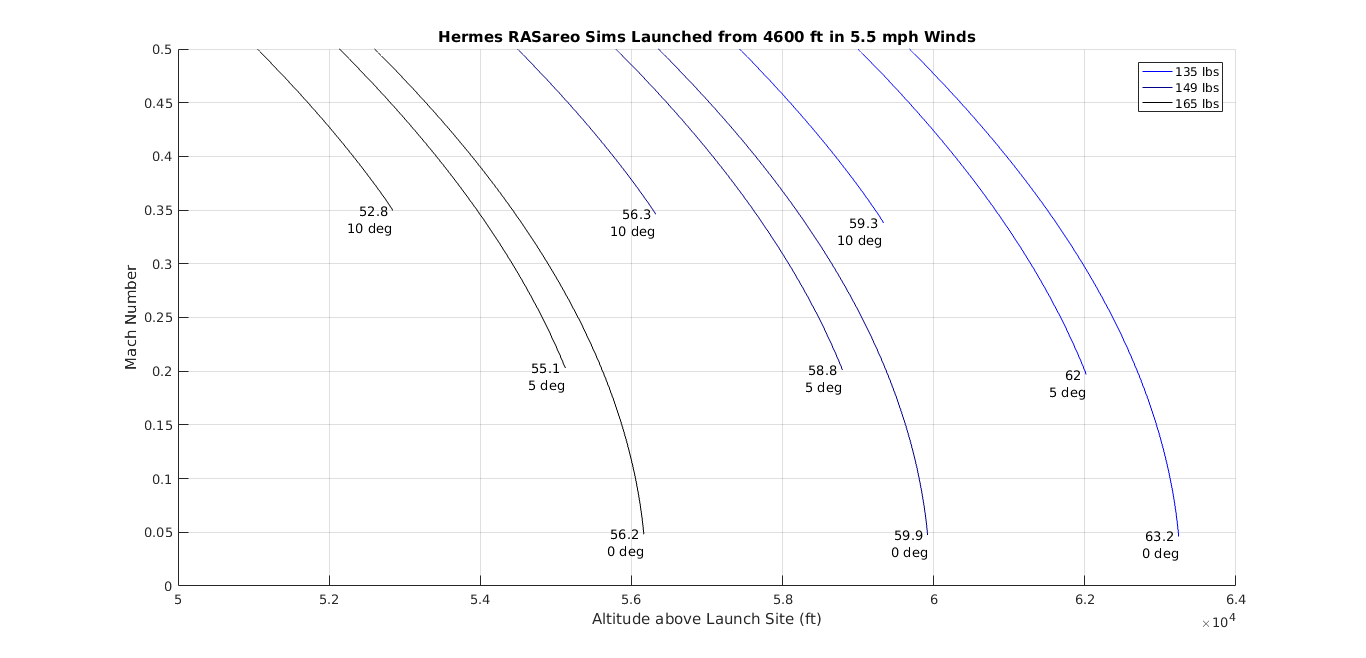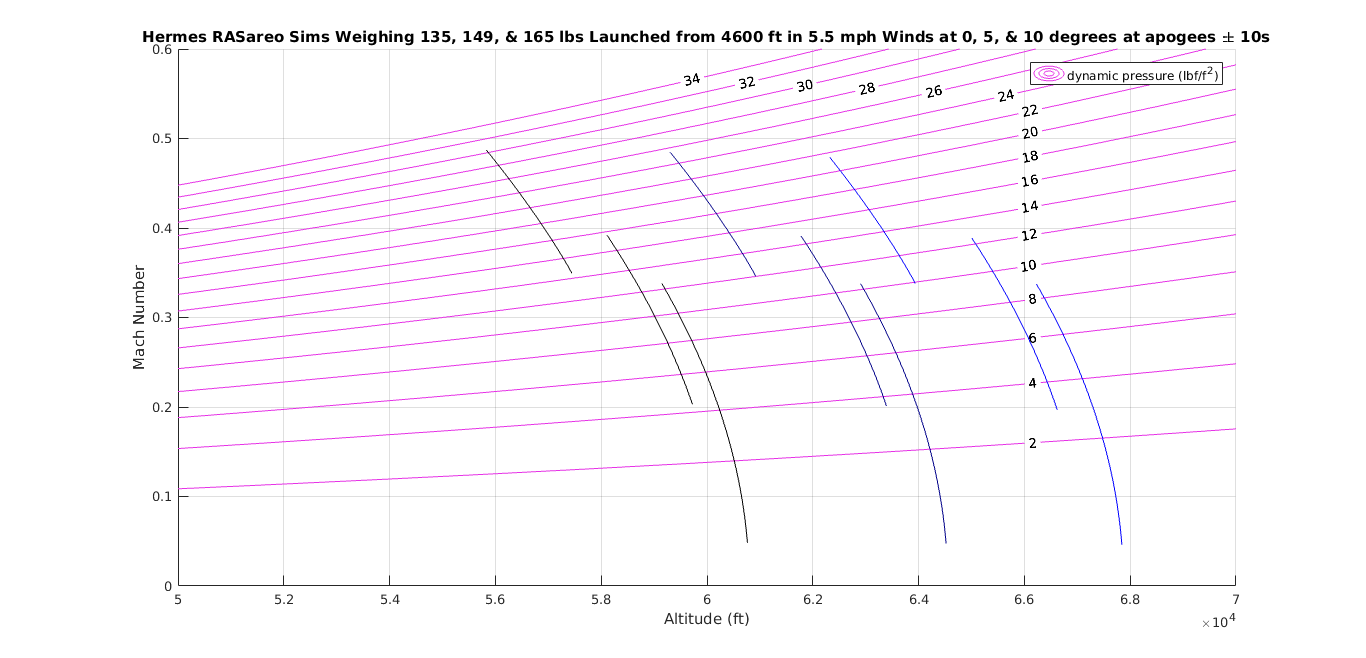Overview
This flight was originally scheduled for June of 2018. It
...
was then scheduled for March 2019.
...
It finally flew on July 6, 2019. This vehicle was a continuation of the work done on Hermes Flight 1.
Recovery:
Add desired landing velocity, landing radius, other expectations
Structures:
All structures survive flight, nothing breaks, materials survive temperature changes
Avionics:
Measure altitude & acceleration and actuate necessary flight events
Payload:
Collect data on nose cone heating throughout flight
Propulsion:
Fly to 80,000 ft, motor performs nominally (no CATO, thrust curve within 5%)
Flight Data Files
Pyxida:
StratoLogger:
...
...
...
Video
Simulator Files:
12-17-2017
I've spent a few hours digging through RASAero, Open Rocket, BurnSim, the Mass Budget, and hitting all of the above with healthy doses of common sense. Andrew gave me a few good ideas on where to start sanity checking our numbers. I know these values still sound on the high side, but I'm inclined to believe them pending flaws inthesimfiles. I would be very happy to hit 80% of these values though, knowing how these kinds of flights go.
In case anyone was curious,therocksimfilethepreviousrasaeronumberswerebasedoffofstillwas usinganoffaxispistonand was almost 2 feet longer than the current design. This has led to some stability problems with the current design. At Burnout we hit a stability margin of 1.11. As this happens at Mach 3.35 I think we should increase the fin size to compensate.
These files are now correct to the design, as I understand it.
Motor file: 70kNs Rev 6
Composite Fin Can, OD of fin collar 6.25 in, 1/4 thick fins. .75 in edge chamfer .05 in rounding on edges.
Surface Finish: Rough Camouflage Pain
Rocket Length 11 feet 8 inches
GLOW is 158 lbs according to Mass Budget
Aft Closure include Boat Tail to 5.6 in aft diameter
Here are the relevant quantities.
GLOW: 158 lbs, +/- 14 lbs
Burnout Altitude: 12,200 ft AGL
Burnout Velocity 3,700 ft/s (Mach 3.35)
Maximum Altitude: 125,600 ft +/- 23,100 ft (from mass deltas)
These values came from some hand runsofRasAero
The next set of values came from OpenRocket on a dataset of 500 runs through Cassandra (Thanks Josh!). The raw values are quite different than the Open Rocket values, but with a healthy fudge factor (screwing with finishes and fin thicknesses) to get supersonic cd's to matchthoseofRasAero, the numbers were similar.Secondsemesterwe should improve Cassandra's aerodynamics. Anyways, Cassandra gives the following
GLOW = 158 lbs
Apogee 131,529 +/- 6,443 ft
Median Apogee = 133,142 (An average flight is pretty close to the average of the flights, which is good)
3-Sigma Altitude = 138,870 ft
Landing Zone = 4.3 miles east of base camp +/- 1.4 miles
FAA COA Suppliment
| PDF |
|---|
| name | MIT Rocket Team March 27,28 Launch COA Supplement.pdf |
|---|
|
1-28-2018
Take a look at the fin profiles on the manual page of the RAS Aero website. I think the only styles that are reasonable to assume that we could manufacture are hexagonal, hexagonal blunt-base, and rounded (not including square, because... yeah). With a realistic, if not generous, tip radius of 0.05 inches and a hexagonal profile, I'm getting 83kft out of a 65,000 Ns motor in a 156 lb rocket. This assumes an ISP of ~212 s, which I think is achievable. Playing around with rounded or hexagonal blunt-base yields lower altitudes, mostly in the 65kft range. I think we should keep the target altitude of 80 kft, and be thankful that things have essentially randomly aligned with that goal. I have attached my motor file and simulation file for your consideration. Other happy news: the rocket will reach a max velocity of ~3100 fps at 13kft, which is only around mach 2.9 at that altitude. Not saying that it is trivial to keep the fins on any supersonic rocket, but < mach 3 makes Matthew's life easier. 4-2-2018
Attached are the sim results that I ran on RASAero. Included are the files that I ran the sim with. The total mass and CG were taken from my (Maddie's) latest local OpenRocket file (attached here). The loaded mass is a little different that the latest mass budget suggests, but I have widened the tolerance from 7% to 10% to account for this. -Maddie
 Image Removed
Image Removed
 Image Removed
Image Removed
Sim files and results: 4-2-18 Sims.zip
OpenRocket file: 4-2-2018.ork
OpenRocket motor file: Insert here
Launch Conditions:
Elevation: 4600 ft
Temperature: 100 F
Barometric Pressure: 29.68 Hg
Wind Speed: 5.5 mph
...


